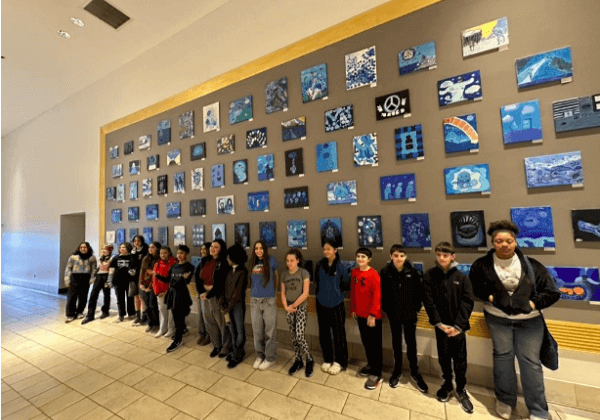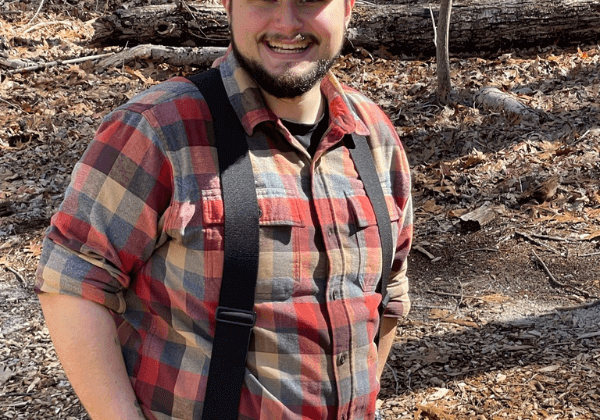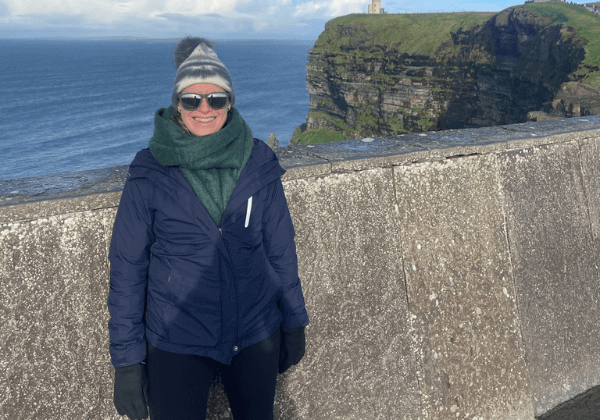Part 2: Interview with Chris Arabadjis
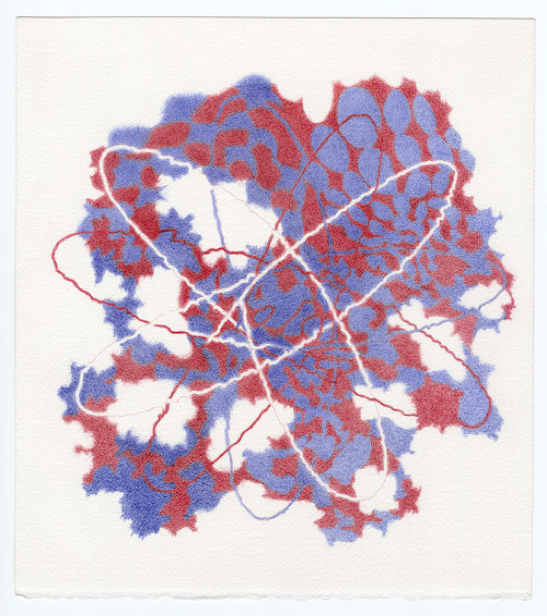
When I was writing my last essay on Chris’s works, we talked at length over email and his answers to my questions were really insightful. Chris also visited my Experimental Drawing class and the students loved him. Below is an edited version of our interview.

Chris Arabadjis, Untitled (2018-04-002), Ballpoint pen on paper, 11.5″ x 10.5″, 2018
John – What was your work like at Pratt and were you working with systems and the organic building of pattern then?
Chris – I drew with string dipped in sumi ink. The pieces were systems, but not incrementally built form or pattern. I like that they looked like data – weather patterns, x-rays, manifolds, simulations, etc. Although I thought of the work as more diagrammatic than gestural, it was the gestural quality that eventually pulled me away from this type of work. I did not want to be an abstract expressionist.
John – Who are some main artists who have influenced you?
Chris – When I was drawing with string, I used to look at Leonardo’s Deluge Drawings a lot. I particularly liked how his careful observation lead to new ways of presenting natural phenomena. Terry Winters’ re-presentation of patterning from scientific sources was an eye-opening experience. I loved his work. Still do. But was very bothered when I heard him say he knew nothing about science and did not have much of an interest in it. He just used it. After that I kind of thought of him as the Jim Dine of science patterns – he drew them so much that they became second nature to him. Jonathan Lasker’s painting has been a touchstone because his work is so completely self-contained. Almost like mathematical theorems. I really admire how his work does not rely on the outside world and yet is so deliciously sensual. Tomma Abts is another painter like this whose work seems to examine its own assumptions. Hilma af Klint’s work made me realize I could invent my own way of thinking without worrying too much about embracing non-rational ideas. James Sienna’s work showed me that you can do anything as small as you like, just do it well. I was very inspired by the looseness and color of Chris Martin’s recent show at Anton Kern. It now affects me every time I start to draw.

Hilma af Klint, Svanen (The Swan), # 17, Group 9, Series SUW, October 1914 – March 1915

Terry Winters, Untitled, 2011, Graphite on Paper, Courtesy the artist and Matthew Marks Gallery
John – I’m interested to know how the aesthetics of science affects your visual inclinations as well?
Chris – I have a strong connection to diagrams. Although I did not draw independently between Junior High School (1976) and my first art class at the local community art guild (Northampton, 1993), I used to spend a lot of time carefully drawing diagrams on my physics homework, especially in grad school. Mechanics, quantum mechanics, electricity and magnetism, quantum field theory, general relativity all had particularly nice diagrams as I recall. I had several really great professors in grad school who meticulously drew diagrams on the chalkboard while giving lectures. One used to color coat them in 4-6 colors. They were amazing!
As a teaching assistant I ran a homework review session for a class that students could drop in at during their free time. They were very popular and I would create my own meticulous drawings on the blackboard and insist that students be very accurate with their drawings.
When I was very young my parents purchased the Time Life series called Nature Library. In it there was one volume called The Sea. In that book there were two foldout diagrams that I obsessed over, reproducing and learning to draw them. It was the combination of aesthetics, design, and information. They were so shiny and intensely colored, and the fact that they folded out beyond a normal centerfold made them even more special. (See below: cover, complete foldout of one image, foldout of second image, and partial first image again with actual color intensity as I remember it.)
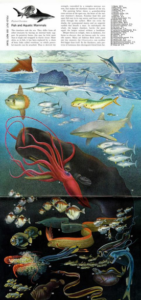

When I (re)discovered Ernst Haeckel’s book Art Forms in Nature after moving to NYC, I thought I knew there must be a community for me somewhere. And even later seeing Leonardo’s Deluge Drawings I thought this way he drew by hand combined the sensitivity of touch with aesthetics and information.
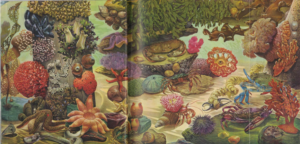

Leonardo da Vinci, A Deluge, 1517-18, pen and black ink wash on paper, 16.2 X 20.3 cm
John – When did you start making drawings on the train and what sparked that?
Chris – Shortly after getting my MFA at Pratt in 2001. I had taken a drawing class with the sculptor Jillian Jagger. One day Jillian asked the class which kind of artist are you – the kind who makes work in great spurts of productivity followed by periods no work or the kind of artist who is steadily making work all the time? At the time I did not know what kind of artist I was and had not thought of dividing up artists’ practice this way. But I decided right then and there that I was the kind of artist who made work steadily all the time, and that’s what I became from that moment on. And still am today. I made sure I always had my sketchbook. I carried it everywhere. I went through many incarnations of drawing. One period was simple line drawings (loose scribbles) about 3″ x 5″ with a ballpoint pen, paying particularly close attention to line thickness and how a line crossed a previously drawn line. Before going to Pratt, I used to draw people on the train. Most people liked it when they noticed what I was doing, but a few felt violated.
In October 2010 I realized that all the drawings in my sketchbook would never be seen by anyone, so I decided to start making finished drawings on the train. I made a drawing kit using the type of packaging that is used to ship record albums. I cut up larger sheets of paper which is much cheaper than buying small sheets of pre-cut paper. I continued using ballpoint pen which sometimes globbed on the page. So I use a folded 8 1/2 x 11 scrap sheet of paper which I rest my hand on as I draw so as not to smudge the ink. I also roll my pen tip on it periodically to prevent globs from accumulating. I use a Bic pen which globs the least and has a nice dry consistency. I prefer a medium tip which produces a wider line for better coverage. And I use the cushioned “Softfeel” type that helps prevent calluses which makes my fingers sore.
John – Do you encounter any technical challenges of drawing on the train?
Chris – Yes, the most obvious challenge is the jiggling of the train. I realized over time that if I stopped drawing when the train got too jiggly my drawing would shift its character. It kind of ruined what I was doing. So I forced myself to continue drawing even when it got bumpy. When people ask how I do it, I tell them one of the following: I draw through the bumps or I draw around the bumps. It’s a funny way of saying there are two different ways of working. I do both. Basically, I let the train teach me how to draw on the train. The way I make drawings now is only with small hash lines – usually an inch or so at the longest. It was not the first time I learned from a machine. Previously I had spent time watching large printers print out renderings of student work at one of the campus’ print labs. There was this way the large cartridge had of moving back and forth rhythmically that produced a consistent shade of color. I had not seen a human draw that way and made it a point to learn how to do that. A few tips: (1) pick a seat toward the center of the car. It moves a lot less than the ends. (2) Choose a seat that is not facing front or back, but to the side. You can brace yourself with your legs better and your fellow passengers help stabilize you. (3) Keep your drawing arm as free as possible.
Two other challenges that are not technical:
One – embarrassment. I use to get embarrassed when people would watch me draw. I didn’t want people to see me make mistakes. It doesn’t happen anymore because I realized that most people are not artists. They don’t know what you’re doing and couldn’t do any better than you. Also, people look at their cellphones on the train way more than each other or someone drawing.
Two – ballpoint pen mistakes. I draw systems of marks built up from patterns so mistakes happen. And they show. I used to hate when I would make a mistake. Now I realize that mistakes are actually creative. It’s taken me a long time to realize this. Of course, an unintentional mark must fit into the drawing as much as any intentional one. Drawings are problem solving environments. A “mistake” is just one more (unanticipated) mark that has to be welcomed into the drawing. Nothing more. The drawing is actually richer for it.
John – Do you have any advice to your artists just starting out?
Chris –
A. Listen to your work. It’s a conversation. You are controlling the medium with your will – that is your speaking role. However, the medium has limitations and so does your hand and your body. Watch for how those limitations show up in your work. Listen to them. Make friends with them. Work with them. It took me a long time to learn this. It’s hard to learn this, but there is no way to go around this. No way.
B. Art does not come from facility. You start to explore a medium, a subject, and way of working by making a few pieces, and then you feel like you’ve finished. That’s when it gets hard. You’ve made the first things that seem easy for you. Maybe they are even good. That is facility. Real exploration comes next. How do you push deeper? It’s hard. To get through this point, you must find where the pleasure is. What makes you happy. It can be something incredible small. It’s usually not big.
C. Talk to other artists. Develop relationships. Show them your work. Ask to see theirs. Be constructive in your criticism. Start with the positive things you see because people hear better when they feel understood. Artists are not always socially comfortable. That’s partly why we make art. Learn to ask questions of more experienced artists. Don’t try to impress them. Just listen. That will impress them.
D. Take your art seriously. You don’t have to take yourself too seriously, but never speak poorly about your work. It is a gift.

